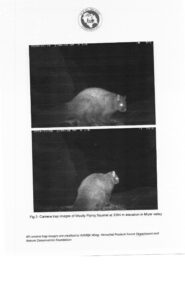 Shimla: Himachal Pradesh’s Wildlife wing and Nature Conservation Foundation(NCF)claims it has captured the first-ever photographic evidence of the elusive Woolly Flying Squirrel (Eupetaurus cinereus) in the Miyar Valley of Lahaul and Spiti district. This rare documentation was made during a camera trapping survey conducted from 10th October to 4th December, 2024.
Shimla: Himachal Pradesh’s Wildlife wing and Nature Conservation Foundation(NCF)claims it has captured the first-ever photographic evidence of the elusive Woolly Flying Squirrel (Eupetaurus cinereus) in the Miyar Valley of Lahaul and Spiti district. This rare documentation was made during a camera trapping survey conducted from 10th October to 4th December, 2024.
The official said the Woolly Flying Squirrel, endemic to the north-western Himalayas, was long believed to be extinct until it was rediscovered in 1994 after a gap of nearly seventy years. Its confirmed presence in the hill state marks a noteworthy addition to the state’s mammal checklist.
The camera trapping survey was part of the Snow Leopard Population Assessment in India (SPAI) initiative was aimed at studying snow leopard populations and their habitat. The survey followed SPAI protocols and involved the installation of 62 camera traps across strategic locations in the Miyar Valley. This extensive exercise was carried out by the Wildlife Wing in collaboration with the Nature Conservation Foundation (NCF).
 The deployment of camera traps across the rugged Himalayan terrain was led by a team of local youth from Kibber in Spiti, who have been engaged in such conservation efforts since 2010. Their efforts were further supported by a wildlife and conservation champion from Lahaul.
The deployment of camera traps across the rugged Himalayan terrain was led by a team of local youth from Kibber in Spiti, who have been engaged in such conservation efforts since 2010. Their efforts were further supported by a wildlife and conservation champion from Lahaul.
He further informed that in addition to the Woolly Flying Squirrel, the camera traps also recorded images of several other key species, including the snow leopard, red fox, Himalayan wolf and mountain weasel. These animals were observed in rocky cliff zones and transitional habitats just above the tree line areas typically favoured by the Woolly Flying Squirrel.
The official said these findings not only shows the rich biodiversity of the Miyar Valley but also provide crucial insights into the high-altitude ecosystems of Himachal Pradesh. Such discoveries also show the importance of continued conservation research and the need to protect these fragile and unique habitats.
